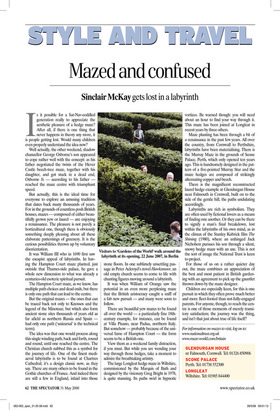Mazed and confused
Sinclair McKay gets lost in a labyrinth Is it possible for a Sat-Nav-coddled generation really to appreciate the aesthetic pleasure of a hedge maze? After all, if there is one thing that never happens in theory any more, it is people getting lost. Would many children even properly understand the idea now?
Well actually, the other weekend, shadow chancellor George Osborne’s son appeared to cope rather well with the concept: as his father negotiated the twists of the Hever Castle beech-tree maze, together with his daughter, and got stuck in a dead end, Osborne Jr — according to his father — reached the maze centre with triumphant speed.
But actually, this is the ideal time for everyone to explore an amusing tradition that dates back many thousands of years. For in the grounds of countless posh British houses, mazes — composed of either beautifully grown yew or laurel — are enjoying a renaissance. The pleasure is not purely a horticultural one, though there is obviously something deeply pleasing about all these elaborate patternings of greenery. It is the curious possibilities thrown up by voluntary disorientation.
It was William III who in 1690 first saw the escapist appeal of labyrinths. In having the Hampton Court maze planted, just outside that Thames-side palace, he gave a whole new dimension to what was already a centuries-old esoteric spiritual pursuit.
The Hampton Court maze, as we know, has multiple path choices and dead ends, but there is only one path that can lead to the centre.
But the original mazes — the ones that can be traced back not only to Knossos and the legend of the Minotaur, but which also form ancient stone sites thousands of years old as far afield as northern Russia and Spain — had only one path (‘unicursal’ is the technical term).
The idea was that one would process along this single winding path, back and forth, round and round, until one reached the centre. The Christian church nabbed this as a symbol for the journey of life. One of the finest mediaeval labyrinths is to be found at Chartres Cathedral; it’s a design classic now, as they say. There are many others to be found in the Gothic churches of France. And indeed there are still a few in England, inlaid into those stone floors. In one sublimely unsettling passage in Peter Ackroyd’s novel Hawksmoor, an old empty church seems to come to life with chanting figures moving around a labyrinth.
It was when William of Orange saw the potential in an even more perplexing maze that the British aristocracy caught a sniff of a fab new pursuit — and many were soon to follow.
There are beautiful yew mazes to be found all over the world — a particularly fine 18thcentury example, for instance, can be found at Villa Pisano, near Padua, northern Italy. But somehow — probably because of the universal fame of Hampton Court — the form seems to be a British one.
View them as a weekend family distraction, if you must. But while you are wending your way through those hedges, take a moment to admire the breathtaking artistry.
The large Longleat hedge maze in Wiltshire, commissioned by the Marquis of Bath and designed by the visionary Greg Bright in 1978, is quite stunning. Its paths swirl in hypnotic vortices. Be warned though: you will need about an hour to find your way through it. This maze has been joined at Longleat in recent years by three others.
Maze planting has been through a bit of a renaissance in the past few years. All over the country, from Cornwall to Perthshire, labyrinths have been materialising. There is the Murray Maze in the grounds of Scone Palace, Perth, which only opened ten years ago. This is handsomely designed in the pattern of a five-pointed Murray Star and the maze hedges are composed of strikingly alternating copper and beech.
There is the magnificent reconstructed laurel hedge example at Glendurgan House near Falmouth in Cornwall, built on to the side of the gentle hill, the paths undulating accordingly.
Labyrinths are rich in symbolism. They are often used by fictional lovers as a means of finding one another. Or they can be there to signify a man’s final breakdown, lost within the labyrinths of his own mind, as in the climax of the Stanley Kubrick film The Shining (1980), where an unhinged Jack Nicholson pursues his son through a silent, snowy hedge maze with an axe. This is not the sort of image the National Trust is keen to project.
For those of us on a rather quieter day out, the maze combines an appreciation of the best and most patient in British gardening with an agreement to pick up the gauntlet thrown down by the maze designer.
Children are especially keen, for this is one pursuit in which they often prove much better and more fleet-footed than not-fully-engaged parents. For anyone, though, to reach the centre is one of those moments of merely transitory satisfaction; the journey was the thing, and isn’t that just about true of life itself?
For information on mazes to visit, log on to: www.nationaltrust.org.uk www.maze-world.com/britain










































































 Previous page
Previous page